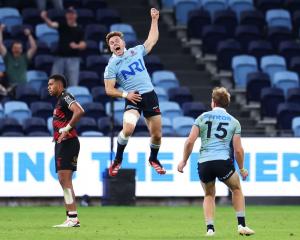ODT Online rugby writer Jeff Cheshire offers his thoughts on last night's victory by the All Blacks over England in Hamilton.
Deeper backline
It was the depth the All Black backs were standing at that allowed them to cut the English to bits in the first half. In the two previous games the English defence has thrived by rushing up, cutting down the All Black space and blocking the pass to the outside, which is where the space was.
This week the All Blacks played with more depth, which gave them more space and allowed them to use the wrap-around for Aaron Cruden to get the ball into the space wide. The English defence was playing as though they were expecting Ma'a Nonu to crash the ball up off first phase, which sucked in far too many defenders. On the first two of these occasions, Nonu did not do this, freeing the ball up to get it out wide to Julian Savea who found himself in acres of space. It happened a third time too and Savea was only to be denied by a forward pass.
Need to police offside line
The English defence has been very good, up quickly, shutting down space relentlessly. But many times they have been up a little too quickly, often not retiring back to the last foot of the ruck. They are smart with this though, as it is usually their wider defenders who are up so fast, the ones that have been cutting down the outside pass. Likewise, they were starting a metre or so in front of the last man's foot when they were charging down Aaron Smith's box kick. This charge-down is not an easy thing to do, yet England were regularly getting away with it. Interestingly Brodie Retallick was penalised for the exact same offence, where the replays would suggest he was fine with what he did.
Set-piece issues
Early on the set-piece was outstanding and it showed in the way the backs were playing. The lineout was kept simple and it was being won, while the scrum applied pressure and really laid a solid platform.
This all turned to custard in the second half, however, and was particularly bad once changes were made in the front-row. The second-string front row struggled once again, conceding penalties and going backwards, limiting the amount of ball the backs had to work with.
The lineout was worse though, with a mixture of ball being pinched, not thrown or thrown in crooked. It was the ones that were not even thrown in that pose the biggest problem. There really is no excuse for these, particularly as it happened twice in a row. The second came from a penalty in which the All Blacks took their time to kick into touch and walked into the lineout. In this situation there is ample time to decide what the lineout call is before the ball has even been kicked.
All that needs to happen then is to walk into the lineout and jump straight away, without a call. To not even get a jumper up is bordering on embarrassing.
Lack of organisation in second half
As a follow on from that, the game in general was far less organised in the second half. The ball was thrown around aimlessly at times and the gaps were not being taken as decisively as they had been early. Tackles were fallen off and too many balls were dropped to really apply any pressure. Even when England were under the pump, the All Blacks just lacked the ability to take their chance and deliver the killer blow. It was not a result of the English being that much better either, it was just that the All Blacks were that bad.
The Highlander influence
The three Highlanders involved in this game were all outstanding. Ben Smith continued on from Dunedin and was arguably the best player on the park, constantly finding gaps in the defence and brushing off tackles with ease. His kick and chase game was outstanding too, finding space in behind the English back line and in one instance, put up a bomb, chased it, made the tackle and got the turnover, which led to a dangerous attacking movement. He has to be the first-choice fullback now.
Aaron Smith was outstanding too, passing well and running good support lines to finish off two tries. His box kick was solid and he put in a few nice kicks late in the first half to find space in behind and give the All Blacks good field position.
Malakai Fekitoa was every bit as dangerous in his first test start as he has been in Super Rugby, running hard at the defence and attracting defenders. What a blessing it was to have him land with the Highlanders this year and a great signing from the coaching staff, thanks Blues.
England need more variety
For all we have heard about England playing a more expansive game plan on this tour, the All Blacks were reading their patterns pretty well towards the end of this test. There is no doubt Marland Yarde is a dangerous runner but the English were looking for him coming into the line nearly every time towards the end of the second half and it became too predictable.
The English defence took far too long adapting to the All Blacks' depth on attack. They were defending far too narrowly and the depth effectively negated the speed the English were coming up at. It was clear the All Blacks had seen what the English defence had been doing, implemented a plan to counteract it, which was carried out to perfection.
It is hard to be too critical of England though, as they have shown great improvements and no doubt will build more variety into their play for the coming season.
Psychological factor?
As much as it perhaps should not be, sometimes it can just be hard to come out fizzing after such a dominant half of rugby. We see it time and time again, rarely a team will dominate a second half after having been so dominant in the first. That is not to say it does not and cannot happen. It reallyis just another challenge for this team to confront, as we seen before, switching off after a dominant period can be costly in big games, particularly with the World Cup in mind.












